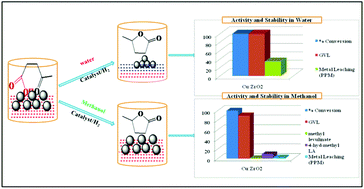Cu–ZrO2 nanocomposite catalyst for selective hydrogenation of levulinic acid and its ester to γ-valerolactone†
Abstract
Several copper based

* Corresponding authors
a
Chemical Engineering and Process Development Division, National Chemical Laboratory, Pune 411008, India
E-mail:
cv.rode@ncl.res.in
Fax: +91 20 2590 2621
Tel: +91 20 2590 2349
Several copper based

 Please wait while we load your content...
Something went wrong. Try again?
Please wait while we load your content...
Something went wrong. Try again?
A. M. Hengne and C. V. Rode, Green Chem., 2012, 14, 1064 DOI: 10.1039/C2GC16558A
To request permission to reproduce material from this article, please go to the Copyright Clearance Center request page.
If you are an author contributing to an RSC publication, you do not need to request permission provided correct acknowledgement is given.
If you are the author of this article, you do not need to request permission to reproduce figures and diagrams provided correct acknowledgement is given. If you want to reproduce the whole article in a third-party publication (excluding your thesis/dissertation for which permission is not required) please go to the Copyright Clearance Center request page.
Read more about how to correctly acknowledge RSC content.
 Fetching data from CrossRef.
Fetching data from CrossRef.
This may take some time to load.
Loading related content
